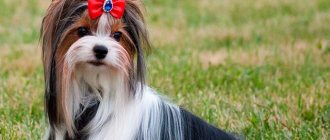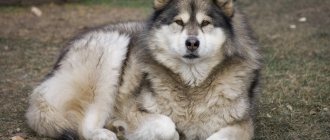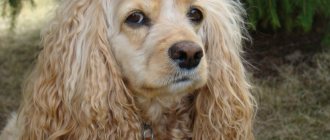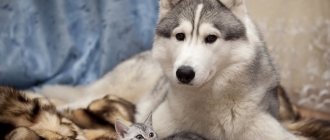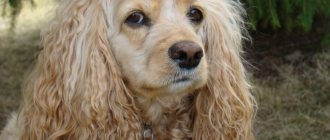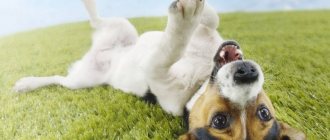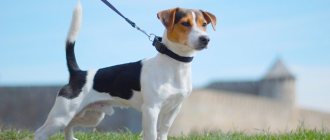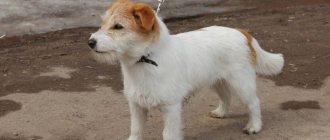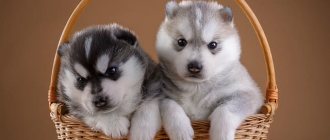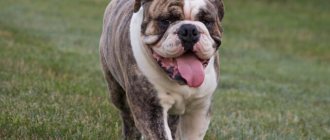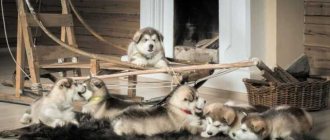art therapy specialist
Description of the presentation by individual slides:
Dog breed - Siberian Husky Completed by: 3rd grade students Victoria Shirinina, Elizaveta Gorbunova, Nelly Novichkova
Introduction We recently watched the animated film Balto, based on real events, which tells the story of Balto, a brave sled dog who delivers a serum to save the children of a town in Alaska. We wanted to know about the dog breed - Siberian Husky. We found a video on a social network about adorable, friendly husky dogs, studied the literature on this topic and decided to create our own project so that people would learn about the features of this wonderful breed.
Project objectives: Find and analyze material about the Husky dog breed Conduct a survey, analyze its results Prepare a presentation Tell the material to students in a fun way
From history The Siberian Husky is a dog breed bred as a sled dog, one of the oldest dog breeds. Currently also used as a companion dog and show dog. The term "husky" (a corruption of "Eski") originally referred to the Eskimos. Subsequently, this name was assigned to the Eskimo Husky. These are dogs with thick hair, a sharp muzzle with erect ears and a curved tail. When the first representatives of the Chukchi dogs arrived in North America, to distinguish them from the Eskimo Huskies, they began to be called Siberian Huskies, and this name has remained with them to this day.
Huskies require long walks with physical activity.
The Siberian Husky has one peculiarity - some dogs have different eyes. Many people tend to choose huskies with different eye colors in order to become the owner of a unique dog with a distinctive feature.
Dogs of this breed are characterized by a smooth and easy gait. The dog is very fast and light. While the dog is moving, the top line of the back remains motionless and level.
The breed standard describes huskies as “friendly and kind, but also attentive and sensitive.”
The favorite pastime for a sled dog is to run in a sled; these dogs will not guard or guard. The purpose of these dogs is to pull.
The feat of the dog Balto At the beginning of 1925, diphtheria broke out in the settlement of Nome. Medicine was needed. An ice storm and storm prevented planes from taking off. Residents of Nome proposed a solution: equip a dog sled and rely on the speed and strength of the dog's paws. The team led by Balto was equipped, and the teams set off into the icy wind and snow. Balto was never considered a great leader, but he showed courage when he plunged into the roar of the blizzard. But the snowstorm intensified, and Balto was also able to stay on the path in the snowstorm.
They walked 53 miles in seven and a half hours. The serum was delivered and was immediately used to stop the epidemic. Five days later, the epidemic was completely stopped. Exhausted and half-frozen, Balto and the rest of the dogs were immediately recognized as heroes in the United States! In one of the New York parks there is a monument to the dog Balto.
Monument to the dog Balto in New York
Conclusion Extremely hardy, playful and adapted to life in nature, the Husky is quite independent. As a companion she is friendly, sociable, affectionate and very calm. She cannot be a watchdog, as she is trusting of strangers and is not aggressive towards other dogs. Huskies are very attached to the family in which they live, but they consider only one person in the house to be the owner. Husky dogs get along well with children and are always happy to communicate with them.
Conclusion While doing this work, we learned a lot about husky dogs. We learned how to create a presentation, conduct a survey and analyze its results. We achieved our goal and created our own product, which we can share with everyone.
Thank you for your attention.
Material number: YES-022549
Didn't find what you were looking for?
You might be interested in these courses:
Leave your comment
16 Russian universities are included in the international QS ranking for the first time
Reading time: 2 minutes
On June 11, graduates take the Unified State Exam in History and Physics
Reading time: 2 minutes
A third of Russians have not read a single book in six months
Reading time: 1 minute
Applicants will be able to enter a university based on their success outside of school
Reading time: 2 minutes
An Italian teacher gave children a summer assignment and became famous
Reading time: 4 minutes
Rosobrnadzor: almost half of teachers do not reach the basic level of training
Reading time: 2 minutes
Gift certificates
Responsibility for resolving any controversial issues regarding the materials themselves and their contents is taken by the users who posted the material on the site. However, the site administration is ready to provide all possible support in resolving any issues related to the work and content of the site. If you notice that materials are being used illegally on this site, please notify the site administration using the feedback form.
All materials posted on the site were created by the authors of the site or posted by users of the site and are presented on the site for informational purposes only. Copyrights for materials belong to their legal authors. Partial or complete copying of site materials without written permission from the site administration is prohibited! The opinion of the administration may not coincide with the point of view of the authors.
Source
History of the breed
The history of the husky cannot be told in a nutshell - this breed is ancient, its origins and development are shrouded in many myths, legends, stories, and assumptions. It is still impossible to say definitively how and when huskies appeared, but there is a mention that the northern peoples lived with them 4000 years ago!
It is officially believed that the breed was developed by the Chukchi living in North-Eastern Siberia. The people were conventionally divided into two types: those who live in the interior of the continent, breed deer, keep dogs, and those who live on the Arctic coast. After the Russian wars for the Bering Strait, the living conditions of the latter deteriorated significantly, and they had to travel quite a long time to hunt to the ocean. Thus, the need arose for strong and hardy dogs that can live in the Arctic cold.
It is known that the Chukchi have always been an autonomous people; more than once they tried to annex their territories to Russia, but to no avail, and only in 1837 did they receive peace and independence; their faithful assistants, the huskies, helped them wait and achieve this. The Chukchi way of life, closed from the outside world, made it possible to preserve the purity of the breed; today this practically does not occur. The Chukchi (unlike other northern peoples and their dogs) allowed huskies into houses so that they would warm children with their warmth, so dogs feel equally good both outdoors and indoors.
Health
Huskies are dogs characterized by good health and good endurance. But, there are some diseases to which they may be susceptible. First of all, it is hip dysplasia. This is a fairly serious pathology that affects the health of the entire musculoskeletal system. Huskies, unable to move normally, have a hard time suffering from this disease. In some cases, only surgery can really help, although this is a last resort. Physiotherapeutic and drug treatment is most often prescribed.
Another group of problems that Huskies may encounter are ophthalmological diseases. Most often we are talking about progressive retinal atrophy and juvenile cataracts.
A cataract is a hardening of the pupil that interferes with normal vision. Juvenile cataracts usually develop in the breed before the age of 2 years. You can get rid of it surgically, although few pet owners agree to this. The main reasons: high risks of unsuccessful intervention and the high cost of the operation.
Retinal atrophy provokes dystrophic changes, which over time lead to complete blindness. Usually two eyes are affected. It is also noted that representatives of the Husky breed are prone to epilepsy.
Interesting facts about huskies
The history of sled dog racing began in 1907 in Nome. The first dog breeders club was founded there, which later grew into sled racing across Alaska. For several years in a row, Leonard Seppala won; he competed on a sled with huskies, which were then called Siberian mice due to their small stature. The Norwegian Seppala initially came to the north to pan for gold and became famous not only for his victories in races. His masterly teamwork and talent as a musher once saved Nome from a diphtheria epidemic: thanks to him, a vaccine was delivered from Nenana in the shortest possible time, in conditions of severe bad weather. In total, the dogs walked 550 km on ice, in a blizzard and blizzard. The sculpture of a sled dog in New York's Central Park reminds us of this heroic event. For a long time, the leader of the sled was the handsome Togo, but after covering an incredibly long and difficult distance and delivering Seppala to the next sled with new dogs, his paws were lost, and young Balto brought the vaccine to the city. The sculpture is dedicated specifically to Balto, although many believe that Togo’s name should be signed under it.
Character
Huskies are kind, but capricious, they need a firm hand, a leader, a leader, whose word will be law for them. Husky puppies test the patience of their owners and test their strength. It is important from the very beginning not to allow anyone to overstep the bounds of what is permitted.
The activity of a dog of this breed is simply off the charts; it is very difficult to tire him physically, but it is necessary. Otherwise, you will have to deal with the result of her pranks and intolerable character from boredom. A husky is ready to jump, run, play, stand on its ears all day long - it’s like a small but incredibly resilient child. By the way, they have excellent contact with children, the dogs love and protect them.
Huskies are smart and intelligent, but this is precisely what prevents quality training. You need to start practicing as early as possible.
Attitude towards children
The dog gets along with children of all ages and loves to nurse and play with them. The best example of the interaction between a child and a husky is the birth of a baby among the Eskimos. During this period, all dogs are allowed to move into the home to keep the newborn warm.
Huskies are devoid of aggression, incredibly smart and understand the boundaries of what is permitted. A Siberian dog can harm a baby only by accidentally stepping on or touching it. If there are no experienced dog owners in the family, get a Husky only when you have the time and desire to train your child and dog to interact successfully.
Purpose
Huskies are recommended for those who need a companion or a show-class dog. Otherwise, this breed did not succeed due to its good-natured disposition. It will not work to use a husky as a service, guard, fighting, or hunting dog; an attempt to develop aggression can result in mental disorders. It is believed that a husky will never bite a person under any circumstances, but keep in mind that there may be characteristics of a particular individual, growing conditions and maintenance.
Description and breed standard
Huskies have medium height and harmonious body proportions. Their head is wide at the top, narrows in the eye area, and has a clear outline. The eyes are almond-shaped, can be brown (yellow-orange) or blue, the ears are triangular, pointed, the tail is fluffy, high, and curled. The legs are powerful and muscular.
The weight of a male is in the range of 21-28 kg, of a female - 16-23 kg. The height at the withers of a male should be 54-60 cm, of a female - 50-56 cm. The typical color is black and white or dark gray with white, sometimes brown, brown with white, pure white or black. There is a mask on the forehead, black or white. The Husky's coat is very thick, of medium length, with a soft undercoat.
Source
Distinctive features
The breed is medium in size, slightly elongated. The dogs are well built, compact, with strong bones and well-developed muscles. A distinctive feature is their bright fluffy fur and pointed muzzle, which makes Huskies look like wolves.
The sexual type is well defined. Males are not coarse, but heavier and larger than females: 53-60 cm at the withers. Females, on the other hand, are more fragile and refined and can work equally with males, despite their smaller size.
Patronage of the breed belongs to the USA. The last standard was published in 1995.
- The head is moderately long, not flat, wedge-shaped. The stop and occipital part are outlined and softly expressed.
- The muzzle is shorter than the skull. Wide and full, tapered towards the nose. Filled in under the eyes. The jaw is wide and strong, with a full set of teeth and a scissor bite (the upper jaw overlaps the lower jaw). The lips are thin and well pigmented.
- The nose is large, black or brown, depending on the color.
- The eyes are medium-sized, slanted, set at stop level. The color is acceptable brown, blue, mosaic-colored, different colors of two eyes are acceptable.
- The ears are small, triangular, stand firmly without tilting, and are set high.
- The body is strong, streamlined, with a straight, long back , wide loin and slightly sloping croup . The chest is well descended. The neck is short, but the head is carried proudly. The belly is tucked in.
- The tail reaches the hock joint and is well feathered. In a calm state it hangs down, in an active state it rises like a sickle and bends towards the back.
- The limbs are set moderately wide, straight and parallel. Paws are oval, not elongated, with collected toes. Movements are easy.
- The coat is straight, smooth, not rough, double coat with a soft fluffy undercoat.
- Colors: any from white to black. White markings on the head in the form of a mask are often found.
Report about Husky message
What could be better than a four-legged friend? A dog that greets you every day and waits at the door for its owner to arrive. How she happily licks and wags her tail when she's having fun. There are different breeds of dogs, but there is also one breed that is extremely beautiful and amazing - the Siberian Husky.
The Siberian Husky was bred by the Chukchi people of northeastern Siberia to move easily and quickly through snow.
This breed of dog has very powerful paws and extraordinary endurance. The paw pads protect them from damage and calluses. Also, under a certain load, the husky develops a ribcage and a pulling reflex so that it can even pull cars! There are various dog weights or harnesses for this purpose. The breed also has fairly strong and sharp claws, since in addition to everything, the husky is a good digger. Since the places where the Siberian Husky was bred had a high thickness of snow, it needs to be cleared away in order to get food or get something.
Most often, huskies are black and gray in color, but they also come in amazing red colors. The eyes of four-legged friends come in a variety of shades of blue and dark blue: milky blue, blue, brown and mixed (one eye is brown, the other is blue). The husky's coat is located in such a way that there is a hard, dense undercoat underneath it. Moreover, it is so dense and long that it is almost impossible to wet it. Even if you let a husky swim, he may well come out wet at first glance, then he will chicken out of the water that was on his coat and remain completely dry. The fluffy tail, like that of any other animal, serves as a kind of rudder when turning or stopping and braking at high speed.
The husky's jaw is typical of dogs. The front teeth and fangs are designed for biting and tearing, and the back ones for thoroughly chewing food.
The peculiarity of this breed lies not only in its extraordinary beauty, but also in their ability, so to speak, to sing. Huskies can howl for hours if they like it.
This breed does not have any aggressive gene. A very friendly and cheerful dog, patient with children and very playful.
Interesting answers
Eighth-grader Zina came to the village from Leningrad for the holidays to visit her grandmother. There the war found her. Zina and other schoolchildren worked underground. They walked around the village, seemingly taking a walk, and obtained the most necessary information
There are 2 sections in chemistry: organics and inorganics. Organic chemistry includes many compounds: alcohols, nucleic acids, alkanes, alkenes, proteins, and so on. One of the representatives of this section are fats, also known as triglycerides.
It is difficult to imagine how many viruses and infections live in the same space as us. In fact, the human immune system constantly copes with a huge number of viruses
The first castles of feudal lords began to appear during the time of the Normans - more precisely, they even served as direct protection against them as enemies. Moreover, not only from them, but also from many other warring peoples and tribes
Source
History of the Siberian Husky breed
The Siberian Husky is a dog that has been living next to humans for many centuries. It was bred by the indigenous inhabitants of the Russian Far North. The Chukchi desperately needed a dog that could cover long distances and transport people and cargo from seasonal hunting grounds to camps. Harsh climatic conditions had a decisive influence on both the formation of the animal’s structure and its character.
The spread of the breed beyond its centuries-old habitat began actively in the 20th century. The husky's endurance, ability to work harmoniously in a harness for a long time and good speed were appreciated on the American continent. Alaskan mushers increasingly began to purchase these dogs to participate in sled dog racing. The greatest fame was gained by Leonard Seppala's team, led by the legendary Togo, which did not give up the palm for several years in a row. But this musher and his dogs entered the history of mankind primarily because it was his Togo, leading a team, who covered a huge part of the path of the famous dog relay of 1925, delivering anti-diphtheria serum to Nome. A small town in Alaska, cut off from the world by miles of snowy desert, is overwhelmed by an epidemic of a deadly disease. It was not possible to get to it quickly and safely by conventional means: unfavorable weather and natural conditions were not suitable for air or land transportation. And then people turned to the faithful huskies for help. The sled relay covered more than a thousand kilometers in a record five days, and the city's population was saved. The best dogs, led by Togo, covered 146 km - the maximum distance. The dogs walked eighty kilometers on the ice of Norton Bay in forty-degree frost in a snowstorm. Such a feat became possible only thanks to the instinct, courage and endurance of the leader of the pack.
The last team in this relay were the dogs of Gunnar Kaasen, led by Balto, who got all the glory. In memory of these events, grateful people erected a monument to this dog in New York. Statues of Togo and Balto greet guests at the entrance to ClevelandMetroparksZoo, and when visiting the museum in the small Alaskan town of Wasilla, you can see Togo's embalmed body. To commemorate that incredible relay, Alaska hosts an annual multi-day sled dog race.
Further development of the breed took place on the American continent, since in the 30s in the USSR the selection of sled dogs was considered unpromising.
In the USA, for a long time, special attention was paid to the sports component. The crossing of Siberian huskies with native sled dogs of Alaska led to the emergence of mixed breeds, which became much more successful than huskies in racing competitions, although they did not receive recognition from international organizations - the mixed breeds turned out to be very diverse.
A new direction in the history of the breed - exhibition - began from the moment when E. Seely and L. Demidoff first presented a bright black and white dog with blue eyes to the judges. It was since the 70s of the last century that huskies increasingly appeared as a domestic companion dog, quite suitable even for keeping in an apartment.
The return of the breed to its historical homeland, Russia, occurred in the 90s. The first dogs were imported from Belgium and the Czech Republic in 1995, and after five years the number of purebred puppies reached one and a half hundred.
Source
Features of care
Husky is an unpretentious breed to keep. You need to bathe him a maximum of 2 times a year, as he will keep his coat clean. But molting causes a lot of trouble for owners. Twice a year, the husky begins to shed a lot of hair, so it needs to be combed thoroughly. In three weeks the undercoat will be completely renewed. There is no need to cut your dog's hair, as this can damage the structure of the coat.
It is necessary to regularly clean the ears, eyes and teeth (using a special chewing bone), as well as trim the nails so that the animal does not experience discomfort when walking.
The ideal conditions for keeping a husky are an enclosure in a private house, spacious enough to not restrict the movement of a hyperactive dog. Otherwise, your pet may develop physical inactivity.
It is not recommended to install chain-link mesh, which not only can be easily chewed by huskies, but can also cause injury. A canopy must be installed that does not interfere with natural ventilation and protects the pet from sunlight. Huskies can withstand wind and cold very well, but they cannot stay in the sun for more than 1.5 hours. This is due to the characteristics of the coat.
Apartment keeping of a Husky is also possible if it is a show breed or a companion dog. Living in a confined space can also have certain advantages: Huskies are very sociable, and loneliness becomes a great stress for them. In the apartment, the dog will constantly be in contact with all household members.
Particular attention is paid to the dog's diet. It necessarily includes meat (at least 75%), vegetables and cereals (15%), and fermented milk products (10%).
The breed needs high-calorie food to compensate for energy expenditure during intense physical exertion.
Report on the topic Husky 2nd grade message
Huskies are sled dogs. The blood of northern dogs and wolves flows in them. It first appeared among the Chukchi, about 4000 years ago. She was a hunting assistant. Initially it had the name “exy”. Translated from English, “husky” means “husky”; this dog cannot bark, but only growl and howl. The Eskimo Husky or Canadian Husky is its direct relative; they are very similar in appearance, which is why they gave it the name Siberian Husky. The Russians brought this breed to Alaska in 1907. The dogs had racing qualities, so they began to gain huge demand, they were harnessed to sleds and participated in competitions. Then they became less popular, as they were replaced by motor sleds and air transport. In 1934 in the USA, the breed was given a standard.
Huskies have a unique code that has evolved over many centuries. In a team of 8 dogs, they reach speeds of up to 35 kilometers per hour. They are very resilient and can work well in a team. Thanks to metabolism, they recover very quickly after racing. They overcome distances of up to 250 kilometers. To prevent dogs from tearing their paws on snow and ice, they wear special shoes.
The character of these breeds is very capricious; they need an owner with a strong temperament. They are stubborn and amenable to training, if only they are interested. The dogs are smart and love children very much and are completely non-aggressive. They live up to 12, 15 years.
If you decide to get a husky, then be prepared for the fact that they are very playful. They have a lot of energy, so that they do not misbehave and are obedient, they need to be worn out. You need to walk them a lot and let them run and jump. This is an amazing breed of dog.
Learning ability
The initial training of a husky consists of the puppy learning its name and approaching the owner's call. Once your pet has mastered the exercises, introduce more challenging elements.
Huskies are stubborn and difficult to train.
The nuances of properly raising a dog at home on the site:
- In the house, define areas where the puppy is allowed to be and fence them off with drywall.
- Teach your puppy to use a diaper or litter box. After feeding, take him to a place to relieve himself and hold him there for a couple of minutes. If the puppy goes to the toilet, praise it.
- Be consistent in training - having given a command, force the dog to carry it out with the help of treats or mechanical influence.
- Do not punish your child for wrong actions - instead, develop him and methodically practice commands.
Don't allow yourself to shout at your dog - loud noises will make him go into a stupor.
Siberian Husky: photo, description of the breed, character, reviews
Option No. 2
Siberian Huskies come from the vast expanses of Siberia, so people were forced to domesticate dogs that would not only be friends, but also helpers. In conditions of terrible cold and poor cross-country ability, the Eskimos needed hardy dogs to transport cargo and move in sleighs.
These beautiful and friendly animals, beloved by many, are descended from wild wolves. This is why huskies are so skittish! The Chukchi had to make a lot of efforts to tame them.
Incredibly, this breed has survived to this day only because of the interest of Americans who needed additional labor. Dogs became especially popular in the 1930s, during the Gold Rush. The name “husky” itself comes from a corruption of the American “eski”, which means “Eskimos”. Unfortunately, after the 1917 revolution, these dogs were considered useless and were almost completely removed from Kamchatka.
Today there are many varieties of these beautiful dogs:
Mini Husky or Klee Klay. This dog is suitable for families who love this breed, but with limited space in the apartment.
The Alaskan Husky is a fast and resilient athletic dog. It is considered the most expensive mestizo (crossbreed) in the world.
The Sakhalin Husky is a rare breed of sled dog. Japanese breeders carefully try to preserve the purity of the blood of these dogs.
Siberian Husky. This variety is more suitable for exhibitions or sports competitions, but not for the harsh conditions of the north.
Japanese Husky or Akita Inu. This is a specially bred breed designed to protect the house and its owner. This dog is unlikely to be able to run in a harness. Japanese representatives of huskies became famous thanks to the film “Hachiko” about man’s faithful friend.
With proper care, huskies can faithfully serve their owner and please him for 11 to 16 years. To do this, you need to provide your pet with proper nutrition and high physical activity.
Intelligence
Many people consider these dogs not smart enough due to the fact that they are difficult to train. But in fact, you need to find the right approach to the dog - not just train and learn commands, but interest the husky and become an authority for the animal.
Character
Although dogs of this breed are friendly, they are very capricious and stubborn. To become a real owner for a husky, a person must have a strong character and willpower, because he will have to fight for the rights of a leader. Wolf blood makes itself felt.
One can say about the activity of huskies that their energy is inexhaustible. In order to make a dog more docile, you need to tire him out quite a lot. In winter, you can harness your pet to a sled or sled, and in summer, ride bicycles together. You can also take long walks and even jogs in the fresh air. If you don't exercise the dog, the husky will be too playful.
The attitude of these dogs towards children was established by the Eskimos. In the north, the birth of a child was a great difficulty due to the cold, so when this miracle happened, a pack of dogs was launched from the street into the home so that they would warm the child with their warm fur. Therefore, there is no need to be afraid that the dog will harm the child. But before leaving a child alone with a dog, it is worth observing its behavior. If there is also a cat living in the house, then the husky may well get along with it, especially if they appeared in the house at about the same time.
How to train and raise huskies?
Since these dogs are very independent, they are reluctant to train. But you need to start learning basic commands already at puppyhood, but at 6 months you should give the dog up to an experienced dog handler.
The main rules of house training:
All family members should behave the same way around the dog. If one person praises and another scolds for the same action, the dog simply will not be able to understand what is required of it.
Physical punishment must not be used. With huskies, the “carrot and stick” method does not work due to their character traits. If the owner does not want to end up with an intimidated animal, he should simply reward the dog more often for correctly executed commands.
Repeat the lesson many times. It is advisable to instruct the dog to carry out basic commands at least 10 times a day. If your pet is distracted by something more interesting, it is important to grab his attention and finish the action.
No matter how active and self-sufficient huskies are, there are types of activities that they may not like:
Hunting - you can interest a dog in her, especially when it comes to hunting bears or mice, but she will not bring game, she will eat it on the spot and will not even share it.
Guard the house. Huskies do not historically have the instinct to protect their territory (except for the specially bred Japanese breed). The only thing a husky can do to a burglar who has entered the house is to lick it due to its love of love.
a service dog due to its free disposition and rather wild character.
Do not confuse husky, husky and malamute. The Samoyed husky is much more obedient and flexible, and will never run away from its owner. Huskies are overly curious and can easily get lost. But the Alaskan Malamute is a heavy dog, bred specifically to carry heavy loads. It’s hard not to notice such a dog, because its face resembles not a cunning fox, but a good-natured bear.
Husky dogs are very easy to care for; they can be compared to cats: they are very clean and take care of themselves, so you should not wash them more than once a year. They shed only twice a year, the rest of the time it is enough to occasionally brush their fur well. It would be a good idea to trim your dog's nails with clippers so that they do not injure the pads. In winter, the paw pads are lubricated with wax to prevent cracks. It is mandatory to clean the ears and eyes once every 2 weeks, as well as monitor the condition of the teeth and periodically remove plaque at the veterinary clinic.
Dogs have no hereditary diseases, they have good health and are incredibly resilient, although they are susceptible to epilepsy, which is incurable for them. Many owners, taking care of the health of their pets' paws, put special running shoes on them. You should also be sure to get vaccinated against distemper and heat-treat food so that the dog does not become infected with parasites. The most common places where Huskies are injured are the eyes, ears and joints. Puppies can experience digestive disorders.
Interesting facts about huskies:
If the question arises about whether to get such a dog, then it is worth weighing the pros and cons. You have to spend a lot of time and effort to raise a dog really well. This breed is also quite expensive, especially show-class puppies or those with a brilliant pedigree. But if you make an effort and care for your pet with all your heart, he will certainly respond with affection. Huskies are a real find for families with children, because you need to be active with the dog. And as you know, movement is life.
How to choose a puppy
If you decide to get such a dog, you need to carefully choose it. A husky puppy must be purebred, with a pedigree. Only this can guarantee the presence of characteristic behavioral features. They buy a baby at 2-3 months of age.
Husky puppy
It is advisable to immediately determine the gender of the pet. Males are calmer, but willful and less amenable to training. Bitches are obedient, but cunning and go into heat twice a year. The puppy must be examined before purchase. He must be cheerful and active. The absence of dandruff, nasal or eye discharge is important.
What is the price
The price of a good puppy cannot be low. A dog without a pedigree can be purchased for 6-10 thousand rubles. But she may turn out to be not purebred, with defects or genetic pathologies. Therefore, it is better to buy a puppy from a kennel. Its cost will be higher, but there is a guarantee that the pet will delight its owners with its cheerful, mischievous disposition and unusual appearance. The price of puppies with a pedigree starts from 20 thousand rubles. Premium class show dogs cost at least 50 thousand.
Huskies are popular dogs, beautiful and smart. Even their high price does not stop many. But not everyone can have such a pet. You should not give a husky to a child, or bring it into a small apartment, an elderly person or a homebody. It requires great physical activity, proper upbringing and respectful attitude. Only then will this dog become a beautiful companion, obedient and loyal.
Popular message topics
Oscar Wilde wrote only one novel in his life, but this did not stop him from gaining unimaginable fame. What is so distinctive about his work?
Nature has given people a lot of good things, but sometimes its phenomena are unpredictable and unpleasant. Among the natural phenomena that brings enormous inconvenience and damage to people, the tsunami stands out. Tsunamis are waves that are quite high.
The ancient inhabitants of the seas and, in particular, the planet, originated approximately 500 million years ago. Most mollusks have shells. Scientists have found that the predecessors of mollusks could have been flatworms. These creatures have a huge number of species,
Source
